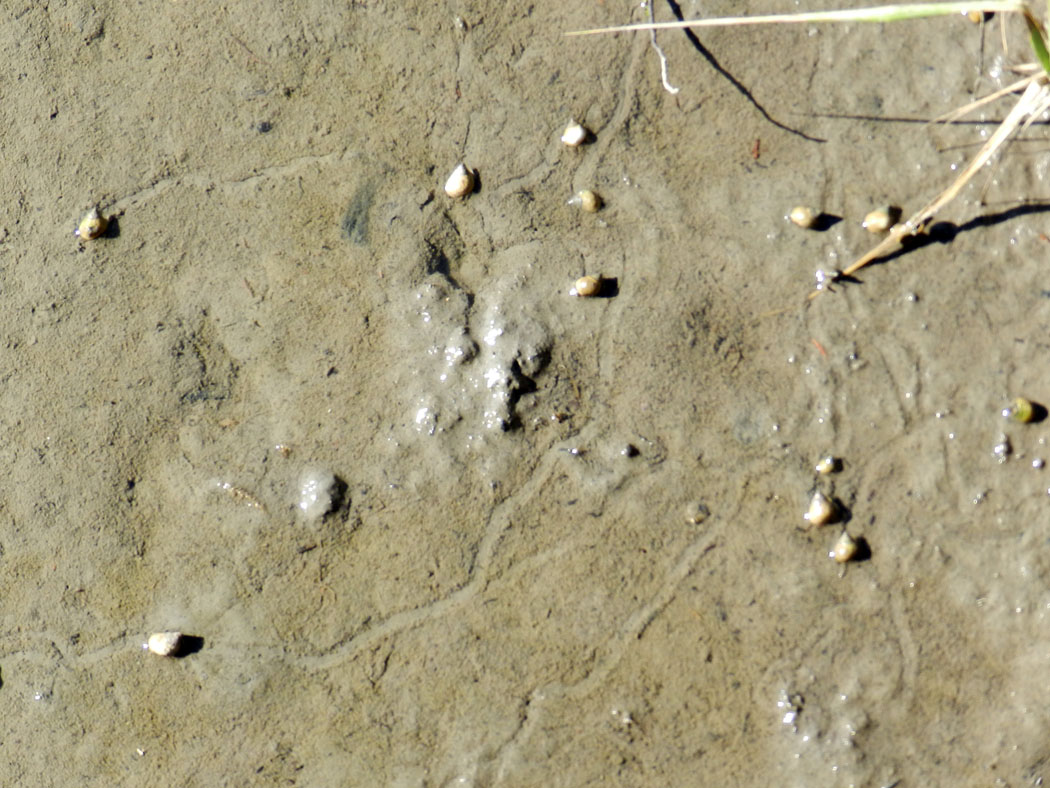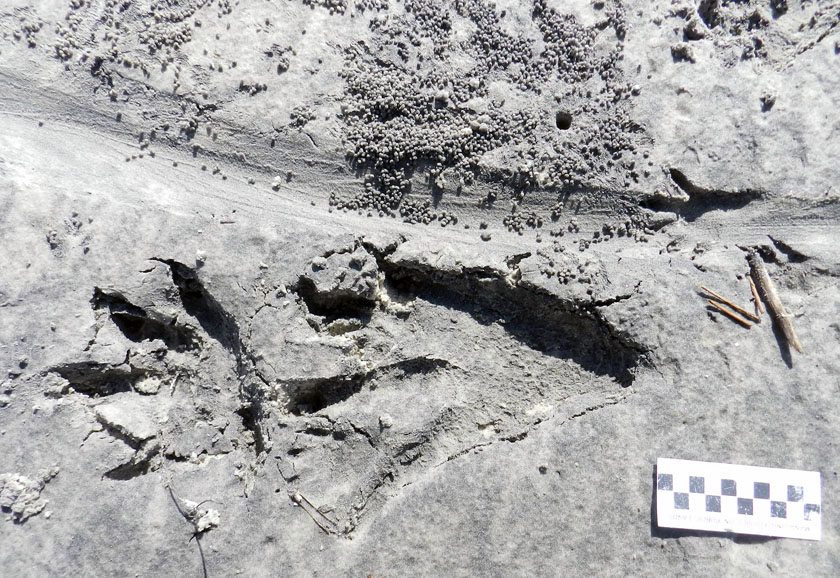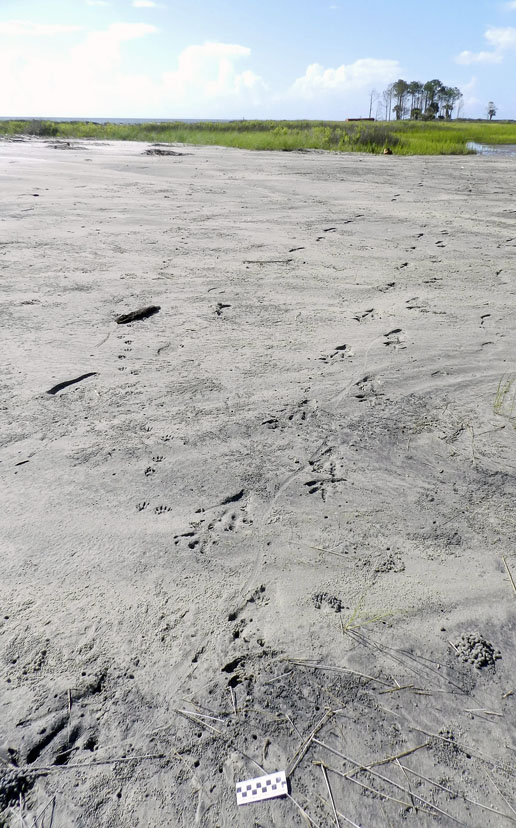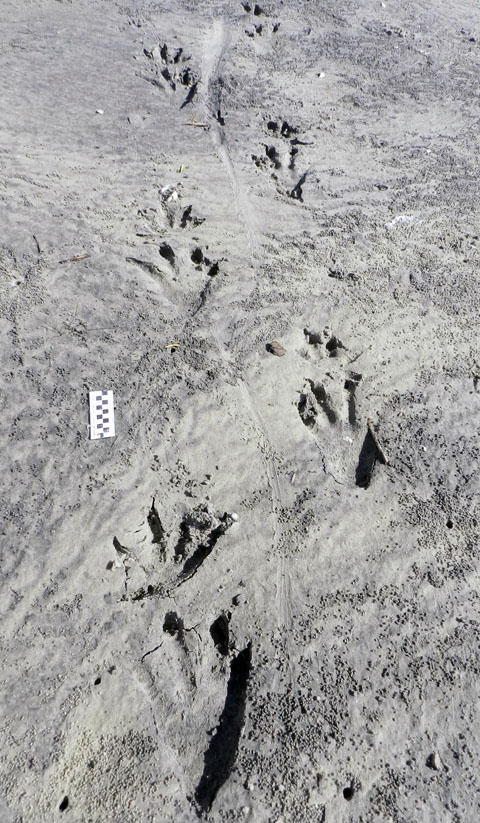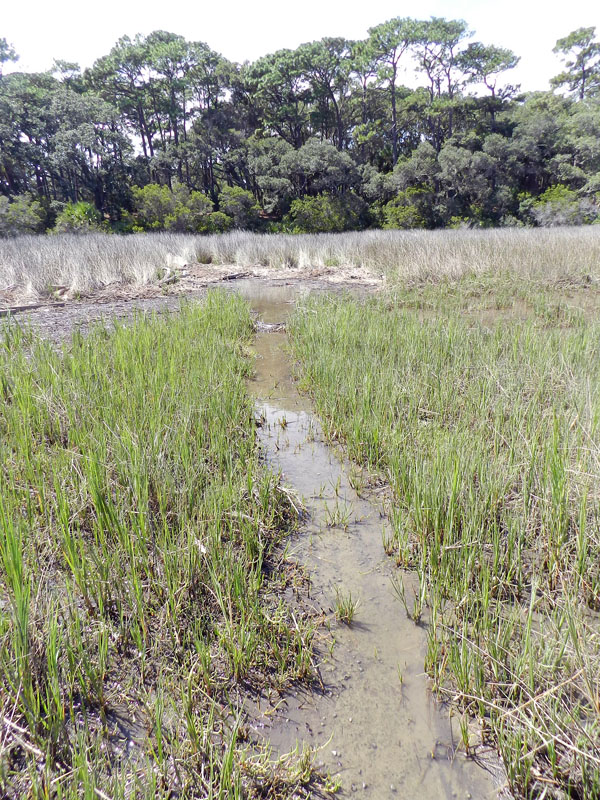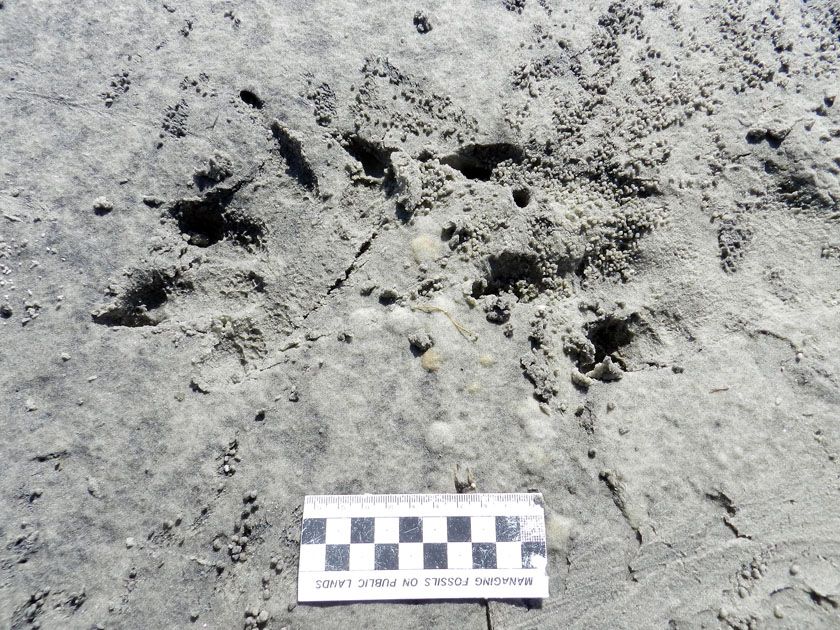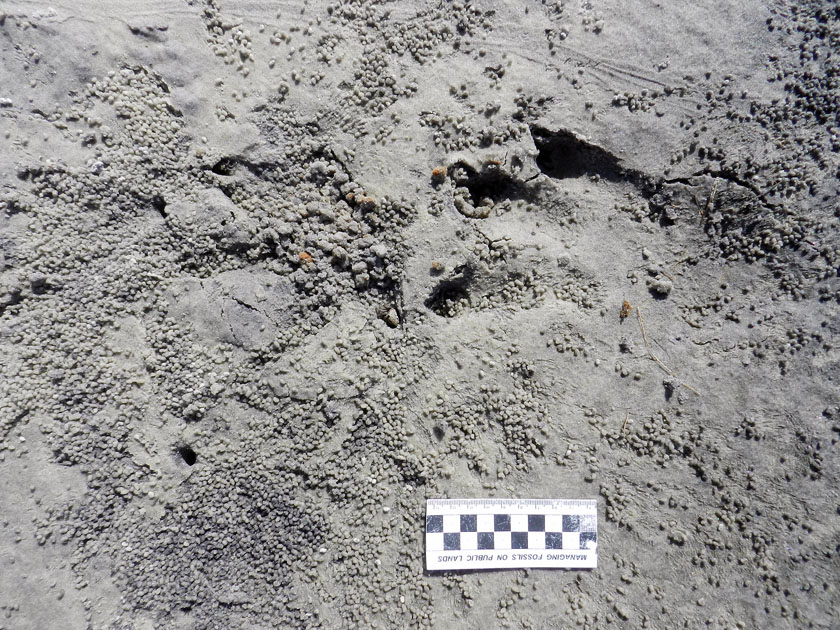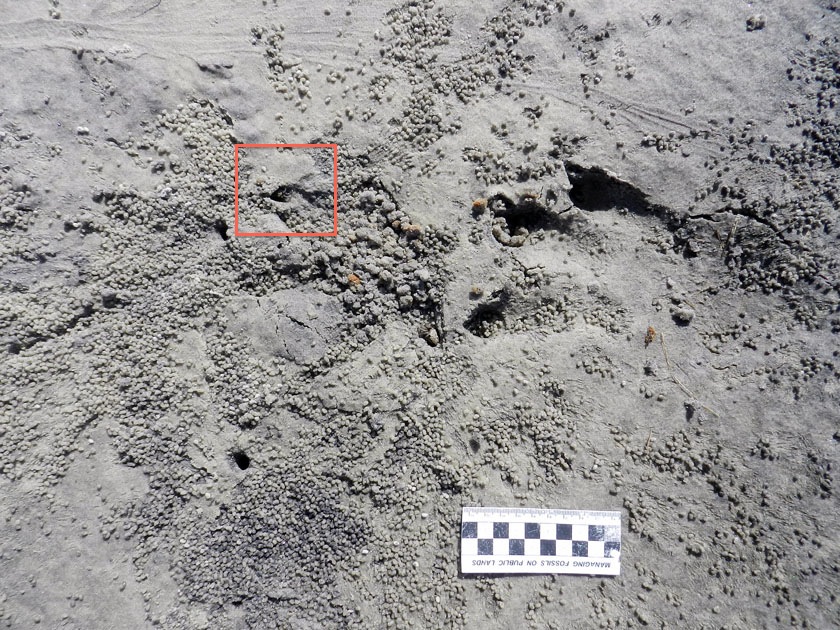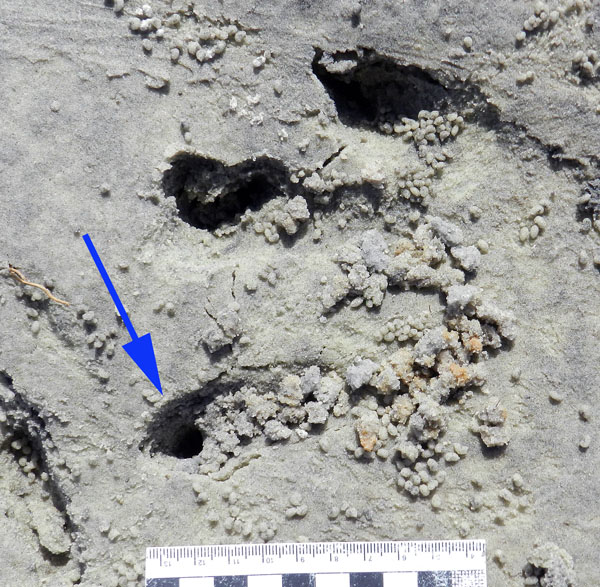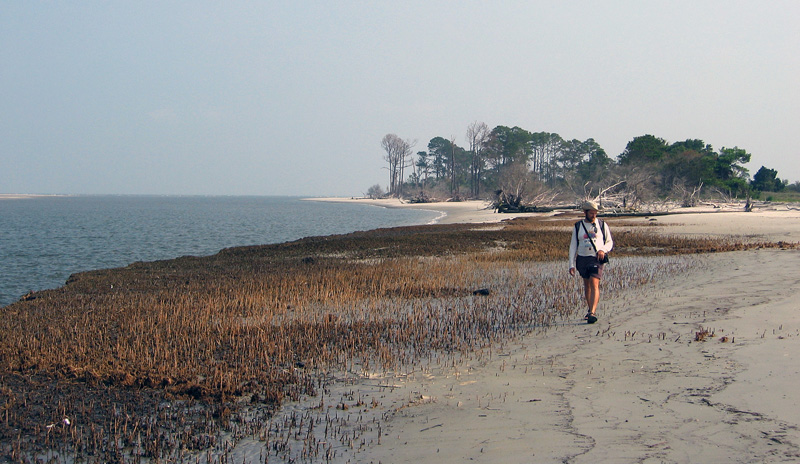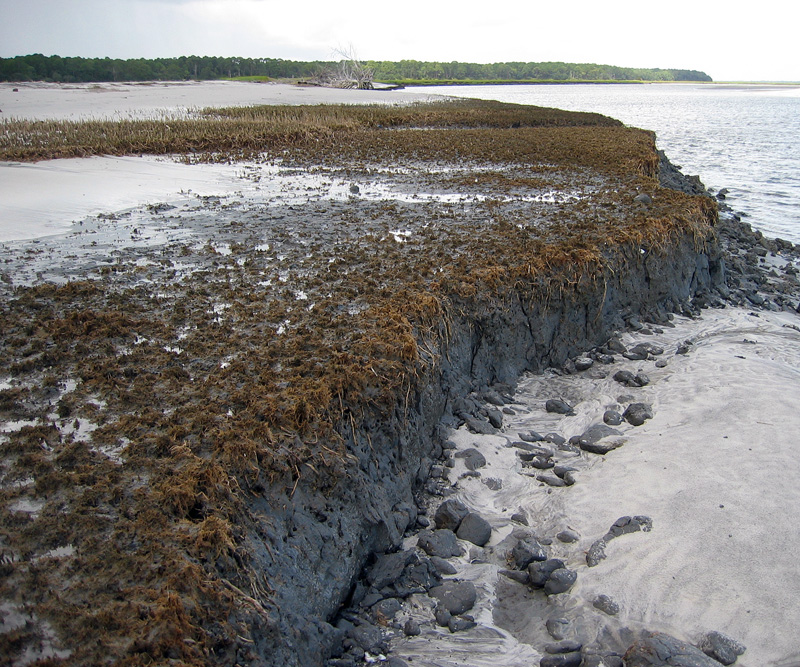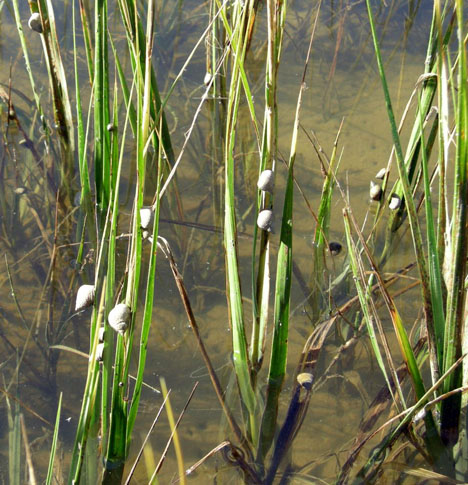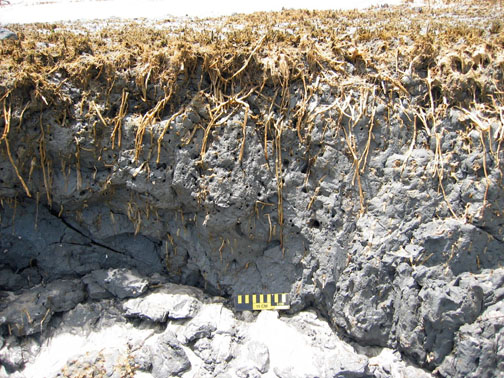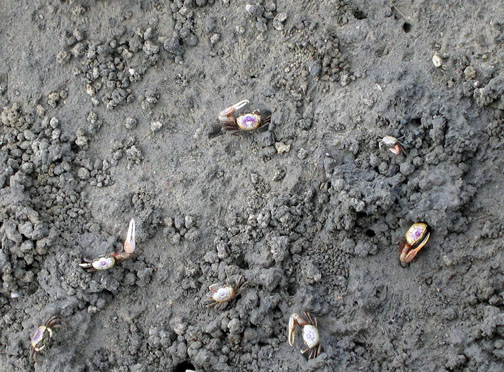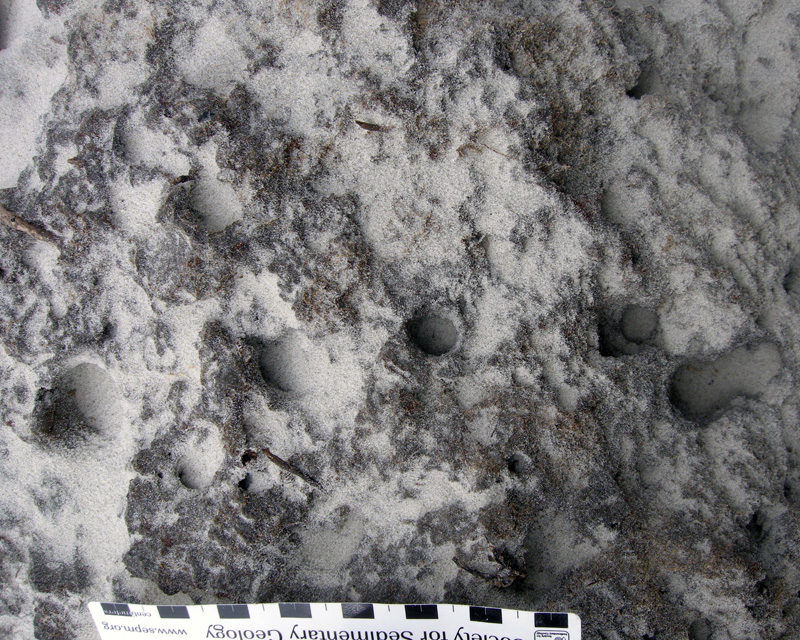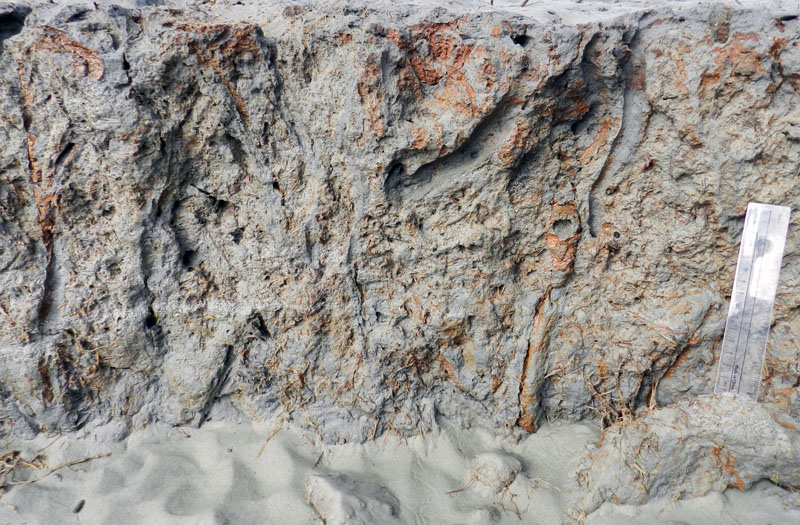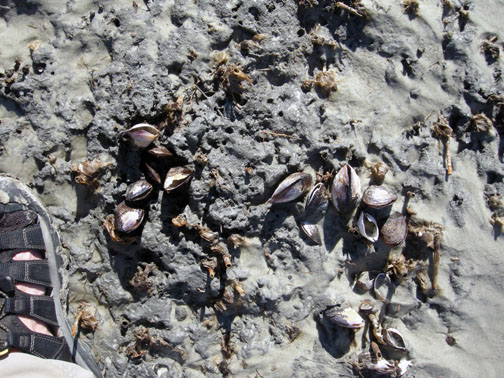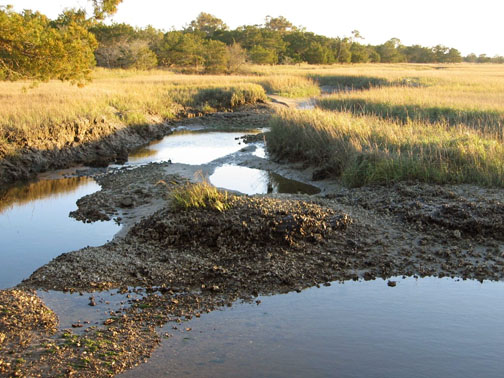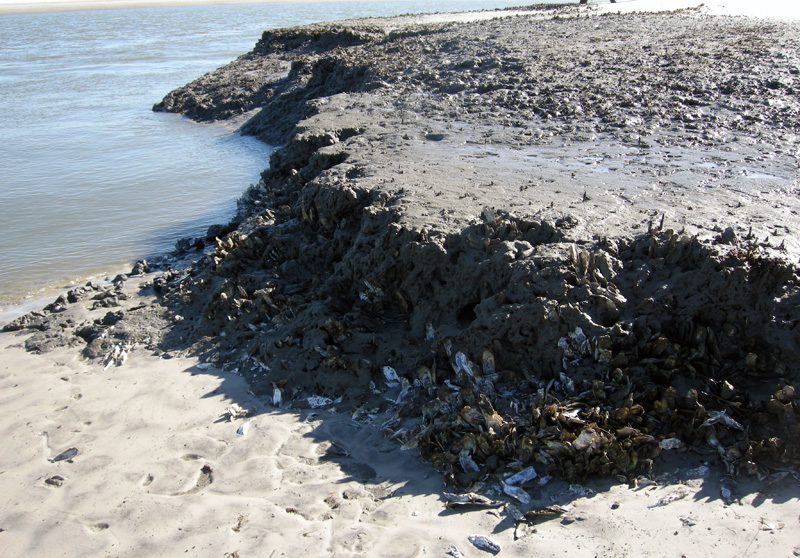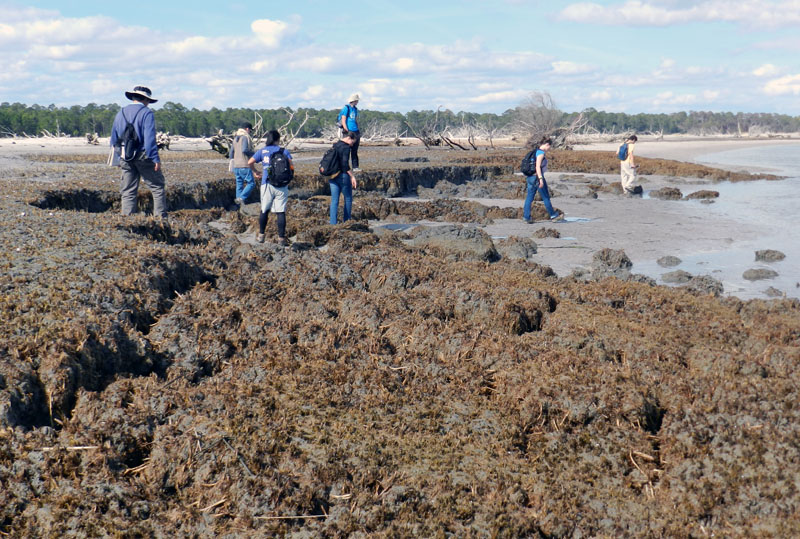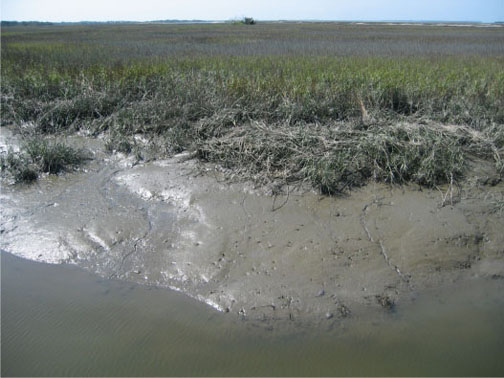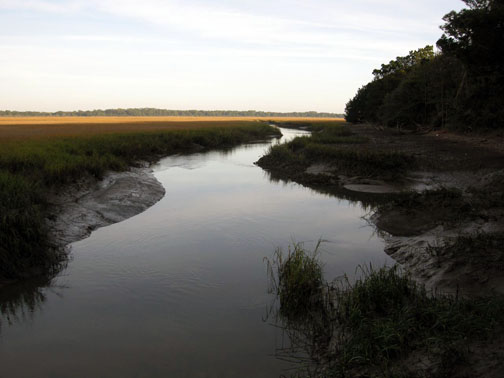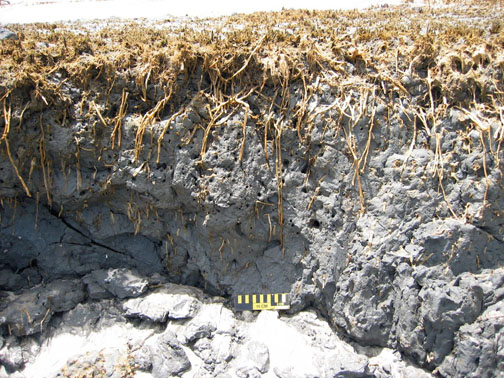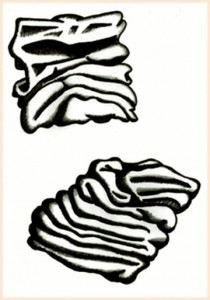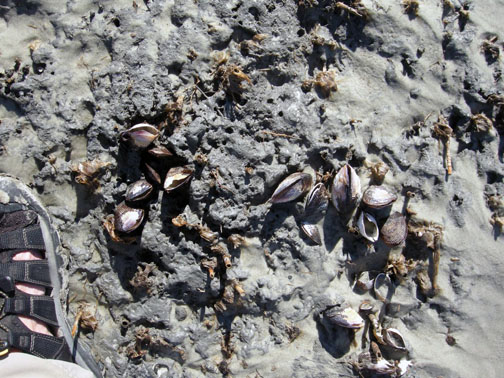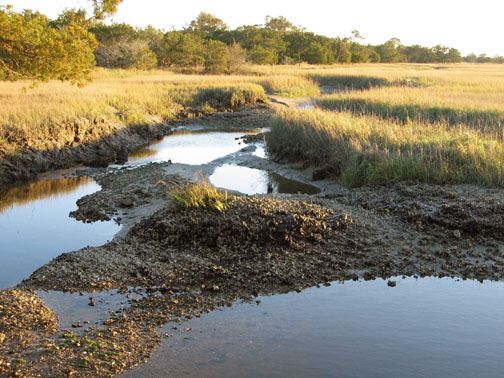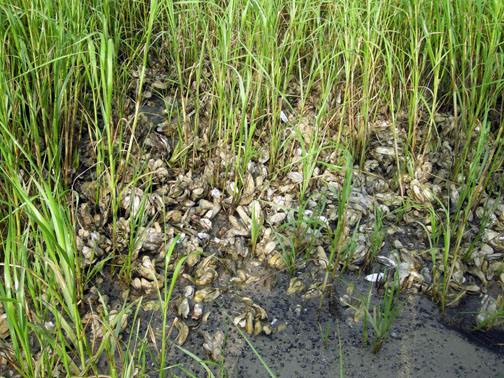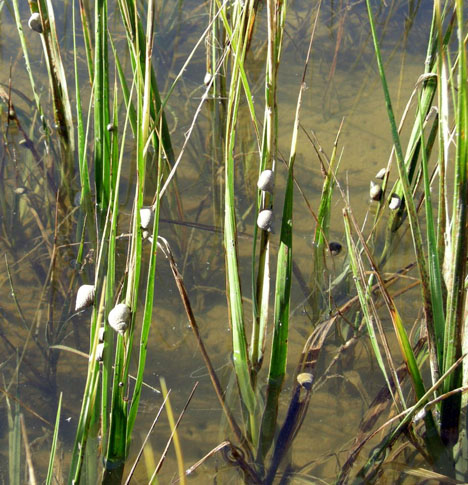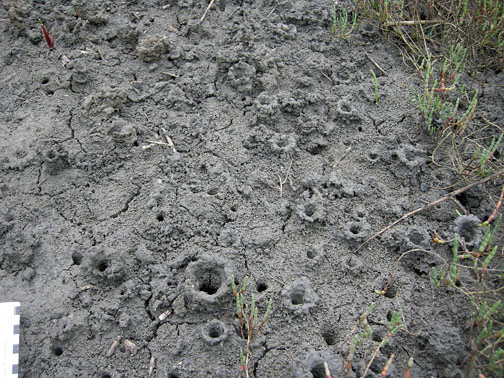(The following is part of a series about traces of key invasive species of mammals on the Georgia barrier islands and the ecological effects of these traces. Here is an introduction to the topic from last month, and the first entry was about the feral horses of Cumberland Island.)
If I were pressed to name my favorite Georgia barrier island, it would be a tough choice, but it would be Sapelo. Many reasons support this preference, both practical and emotional, which I will relate before getting to the topic featured in the title.
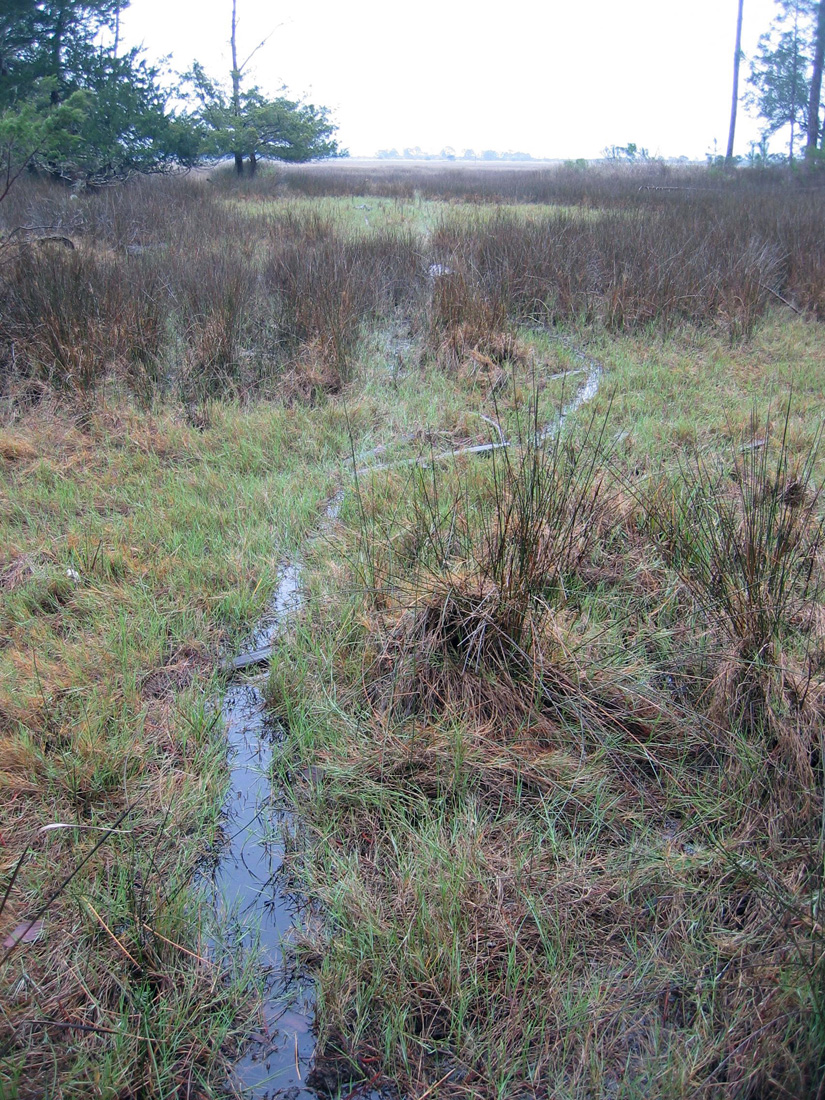 Trails made by feral cattle traveling far into a salt marsh on Sapelo Island, Georgia. But I thought cows only stayed in grassy fields and chewed their cuds? Please read on. (Photograph by Anthony Martin.)
Trails made by feral cattle traveling far into a salt marsh on Sapelo Island, Georgia. But I thought cows only stayed in grassy fields and chewed their cuds? Please read on. (Photograph by Anthony Martin.)
As I mentioned in a previous entry, Sapelo is an excellent place to take university students for teaching basic coastal ecology, geology, ichnology, and taphonomy. Many ecologists consider it as the birthplace of modern ecology, which happened in the 1950s and ‘60s, and it hosted studies that established many basic principles of neoichnology (the study of modern traces) in the 1970s and ‘80s. For the latter, one of the key figures was Robert (Bob) Frey, who was my Ph.D. advisor when I attended the University of Georgia. Sapelo’s human history is also fascinating, dating back to more than 4,000 years ago – evidenced by a prominent Native-American shell ring – and continues through today with Hog Hammock, the only Gullah (“saltwater Geechee”) community left on the Georgia coast.
I have been to Sapelo dozens of times, with or without students, and each time there, I continue to be surprised and delighted by some new observation that reveals itself to those with open eyes and minds. Thus it has everything a field-oriented scientist could want, especially one who likes to learn something different with each visit.
All of these facts and feelings, though, may also lend to an impression that Sapelo is an idyllic and ecologically “pure” place, a true slice of what a Georgia barrier island should aspire to be. Alas, it is not, and like other Georgia barrier islands, Sapelo has been ecologically altered because of exotic plants and animals introduced there during colonial and post-colonial times. Among these species, the most noteworthy on Sapelo is Bos taurus, the only population of wild cattle on any Georgia barrier island and one of the few in the continental U.S.
Unlike the feral horses on Cumberland Island, nearly everyone agrees on the origin of the wild cattle on Sapelo: they are most likely descended from domestic cattle released on the island by millionaire R.J. Reynolds, Jr. (of carcinogenic fame). Although the details are sketchy as to exactly when and why he did this, Reynolds, who owned most of Sapelo from 1933 until his death in 1964, let loose his dairy cows and bulls in the first half of the 20th century. Many generations of these cattle have bred in the wild since, and still roam the island in sufficient numbers to warrant some attention from wildlife biologists, ecologists, and others interested in learning about their behavior and impacts on the local ecosystems.
In my experience, though, the words “wild” and “cattle” are rarely used in everyday conversations about these animals that, through our domestication of them, provide us with milk, cheese, and meat. Ask someone to describe a cow, for instance, and most people will be unflattering: “slow,” “docile,” and “stupid” are among the most common adjectives applied, which is sometimes followed by a giggling reference to the Midwestern U.S. tradition of cow-tipping.
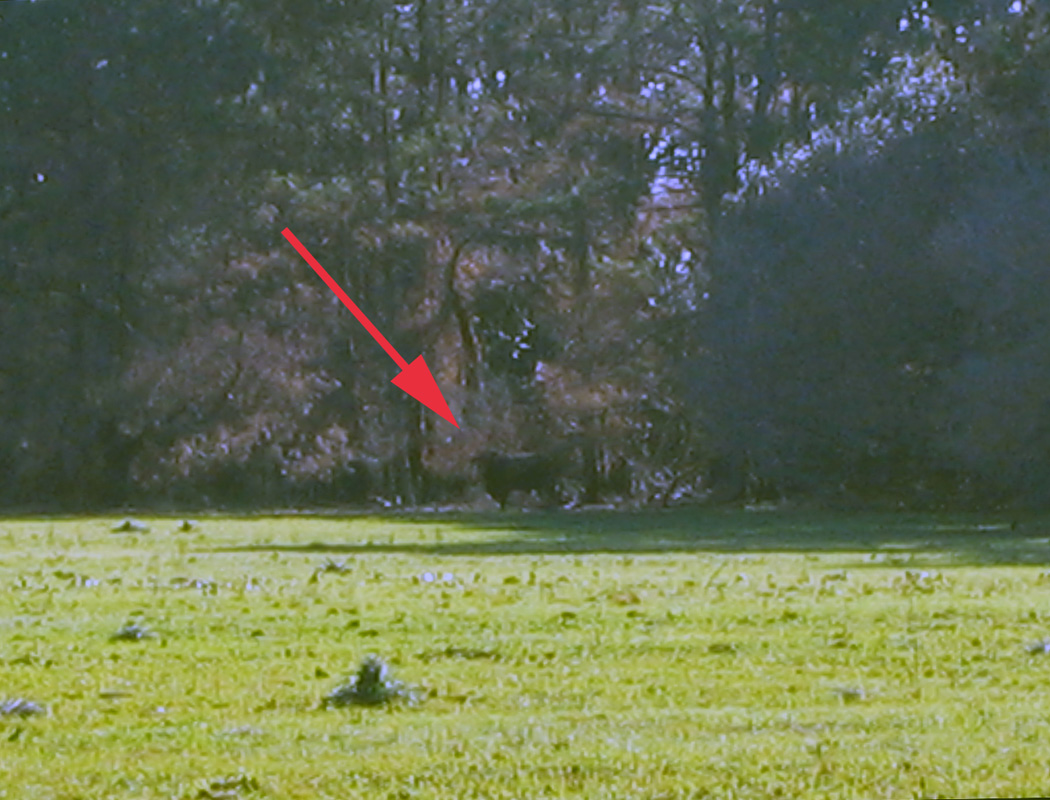 Thinking of tipping this cow? Be my guest, and be sure to forward the resulting video to Animal Planet for others’ lurid entertainment. The “cow” is actually a feral bull, and it was standing its ground at the edge of a field on Sapelo Island, fully aware that we spindly little bipeds were staring at it, and seemingly daring us to get closer. The poor quality of this photo is because I had my camera on maximum digital zoom: my momma didn’t raise no dumb kid. (Photograph by Anthony Martin.)
Thinking of tipping this cow? Be my guest, and be sure to forward the resulting video to Animal Planet for others’ lurid entertainment. The “cow” is actually a feral bull, and it was standing its ground at the edge of a field on Sapelo Island, fully aware that we spindly little bipeds were staring at it, and seemingly daring us to get closer. The poor quality of this photo is because I had my camera on maximum digital zoom: my momma didn’t raise no dumb kid. (Photograph by Anthony Martin.)
Yet these cattle are descended from wild species, aurochs (Bos primigenius) that survived the end-Pleistocene mass extinctions. You know, the same extinctions event that wiped out mammoths, mastodons, giant ground sloths, wooly rhinoceroses, saber-toothed cats, dire wolves, and other formidable megafauna of the Pleistocene. Hence aurochs must have had adaptive advantages over their Pleistocene cohorts. This was perhaps was related to their preferred ecosystems of wetland forests and swamps: remember that point with reference to Sapelo. Following the mass extinction, though, people in Eurasia, Africa, and India domesticated aurochs about 8,000 years ago. Through selective breeding, people came up with the present-day varieties we see of Bos taurus, which is considered a subspecies of B. primigenius.
 Painting titled The Aurochs, by Heinrich Harder (1858-1935), probably made in 1920. Image is in the public domain and I found it on this Web site, authored by Peter Maas. Contrast how the artist depicted an auroch fighting off a pack of wolves with current expectations of how domestic cattle should behave in the face of pack-hunting predators, and you’ll get a better sense of the actual behaviors shown by wild cattle on Sapelo Island.
Painting titled The Aurochs, by Heinrich Harder (1858-1935), probably made in 1920. Image is in the public domain and I found it on this Web site, authored by Peter Maas. Contrast how the artist depicted an auroch fighting off a pack of wolves with current expectations of how domestic cattle should behave in the face of pack-hunting predators, and you’ll get a better sense of the actual behaviors shown by wild cattle on Sapelo Island.
I am reminded of this evolutionary heritage whenever I go to Sapelo, because the cattle there are cryptic creatures of the maritime forest. Yes, that’s right: cryptic and living in the forest. A casual day-trip visitor to Sapelo will almost never see one, let alone any of several small herds that roam the island. Whenever an individual bull or herd is encountered in more open, grassy areas, they seemingly revert to Pleistocene behavior and slip into the woods, quickly concealing themselves from the prying eyes of humans. In short, they are not slow, docile, or stupid, and would never allow a person to get close enough to make an short-lived and ill-fated attempt to tip any of them.
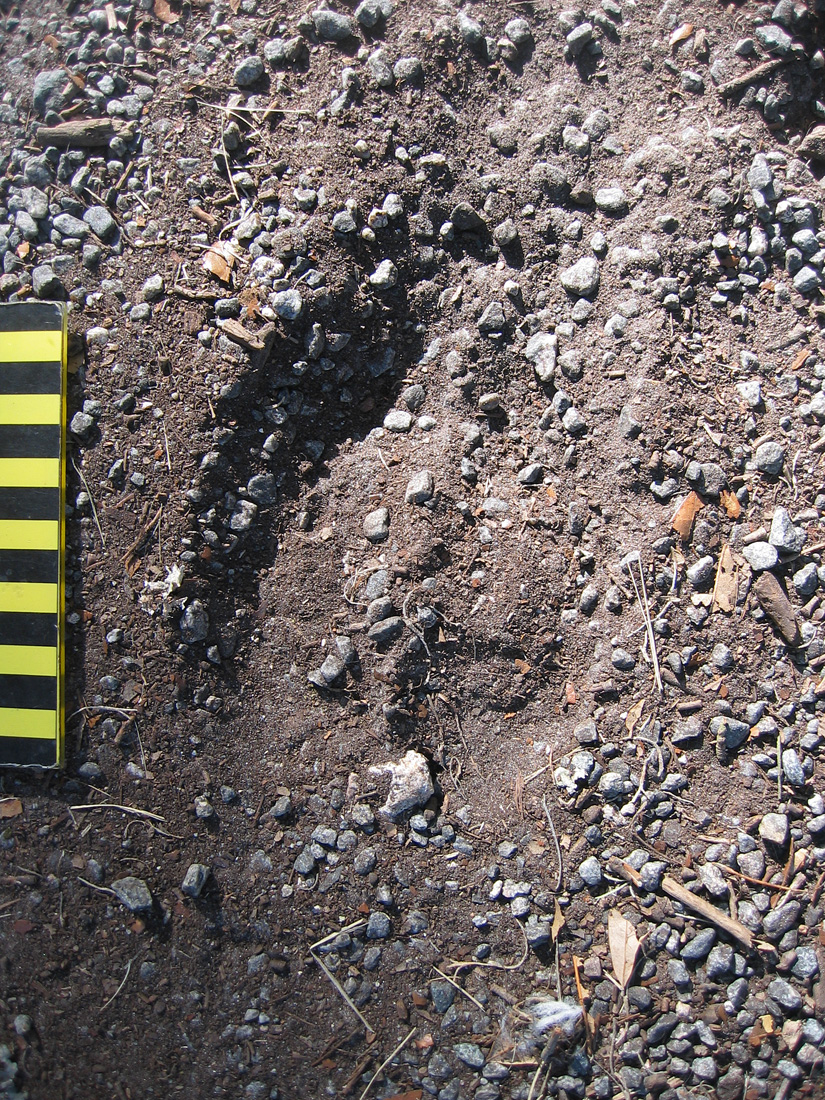 This is about all you’ll see of a recent presence of the feral cattle on Sapelo Island: tracks, and if you are lucky enough to sight one, it will leave a lot more tracks and sign for you to study than that all-too-brief glimpse. Scale is in centimeters, and look closely where the slightly smaller the rear-foot track (manus) registered directly on top of the fron-tfoot (pes) track. (Photograph by Anthony Martin.)
This is about all you’ll see of a recent presence of the feral cattle on Sapelo Island: tracks, and if you are lucky enough to sight one, it will leave a lot more tracks and sign for you to study than that all-too-brief glimpse. Scale is in centimeters, and look closely where the slightly smaller the rear-foot track (manus) registered directly on top of the fron-tfoot (pes) track. (Photograph by Anthony Martin.)
Hence any meaningful study of these cattle and their ecological effects on Sapelo requires the use of – you guessed it – ichnology. Consequently, I have tracked these cattle, sometimes with my students and sometimes by myself, during many visits there. Although these tracking forays have generated many anecdotal yarns of yore about these “wild cows of mystery” worth retelling, I will reluctantly restrict myself here to summarizing their traces and the effects of these traces on the landscapes of Sapelo.
Traces of feral cattle on Sapelo consist largely of their tracks, trails or otherwise trampled areas, feces, and chew marks. In my experience, the vast majority of their traces are on the northern half of the island, although herds or individual bulls will occasionally leave their marks in the southern half when they graze on grassy areas there.
Tracks made by these feral cattle are unmistakable when compared to those of any other hoofed animal on Sapelo – such as white-tailed deer or feral hogs – which is a function of their greater size. Tracks are shaped like robust, upside-down Valentine’s hearts, with two bilaterally symmetrical hoof impressions rounded in the front and back. Tracks are normally about 9-14 cm (3.5-5.5 in) long, although I have seen newborn calf tracks as small as 5-6 cm (2-2.3 in) long; track widths are slightly less (by about 20%) than lengths. These cattle, like deer, spend much of their time walking slowly, so their rear-foot (pes) impressions often overlap behind their front-foot (manus) impressions, but can also overprint in direct register. Trackways typically show a diagonal-walking pattern, although these can be punctuated by frequent “T-stops,” in which tracks form a “T” pattern, with the top of the “T” made by the front feet whenever a trackmaker stopped.
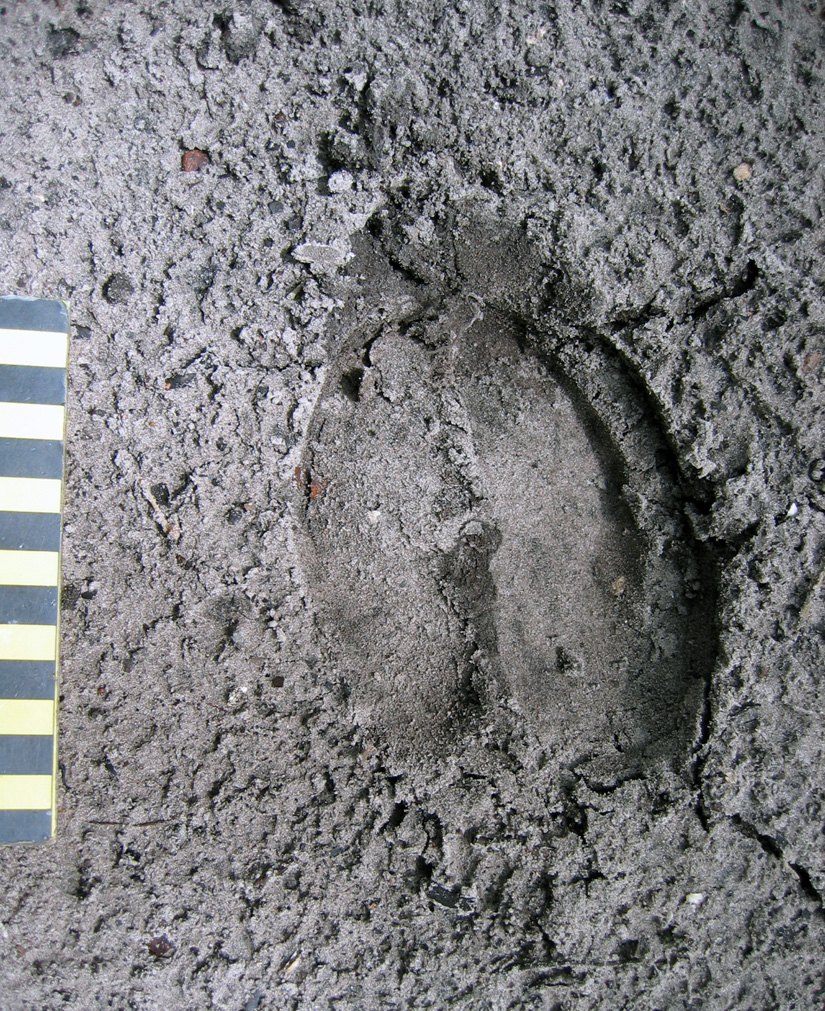 Near-perfect direct register of smaller rear foot into front-foot tracks made by adult feral cow, recorded in exquisite detail in fine-grained sand. Scale in centimeters. (Photograph by Anthony Martin, taken on Sapelo Island.)
Near-perfect direct register of smaller rear foot into front-foot tracks made by adult feral cow, recorded in exquisite detail in fine-grained sand. Scale in centimeters. (Photograph by Anthony Martin, taken on Sapelo Island.)
Because these cattle, for the most part, obey herding instincts, they habitually follow one another along the same narrow pathways through maritime forests and salt marshes, resulting in well-worn trails that wind between live oaks in forest interiors or cut straight across marshes. Nonetheless, the cattle also like to use the open freeways provided by the sandy roads that criss-cross much of the northern part of the island, which makes tracking them much easier, especially after a hard rain has “cleaned the slate.” When using a road, the cattle break single file and walk parallel or just behind one another, indicated by their overlapping and side-by-side trackways. On forest trails, they often drag their hooves across the tops of logs downed along trails, chipping and otherwise breaking down the wood.
 Feral cattle tracks showing different sizes – and hence age structures – of the cattle, with some trackways overlapping (following one another) and some parallel, taking up the entire width of a sandy road on the north end of Sapelo Island. (Photographs by Anthony Martin, composite of three stitched together in Photoshop™.)
Feral cattle tracks showing different sizes – and hence age structures – of the cattle, with some trackways overlapping (following one another) and some parallel, taking up the entire width of a sandy road on the north end of Sapelo Island. (Photographs by Anthony Martin, composite of three stitched together in Photoshop™.)
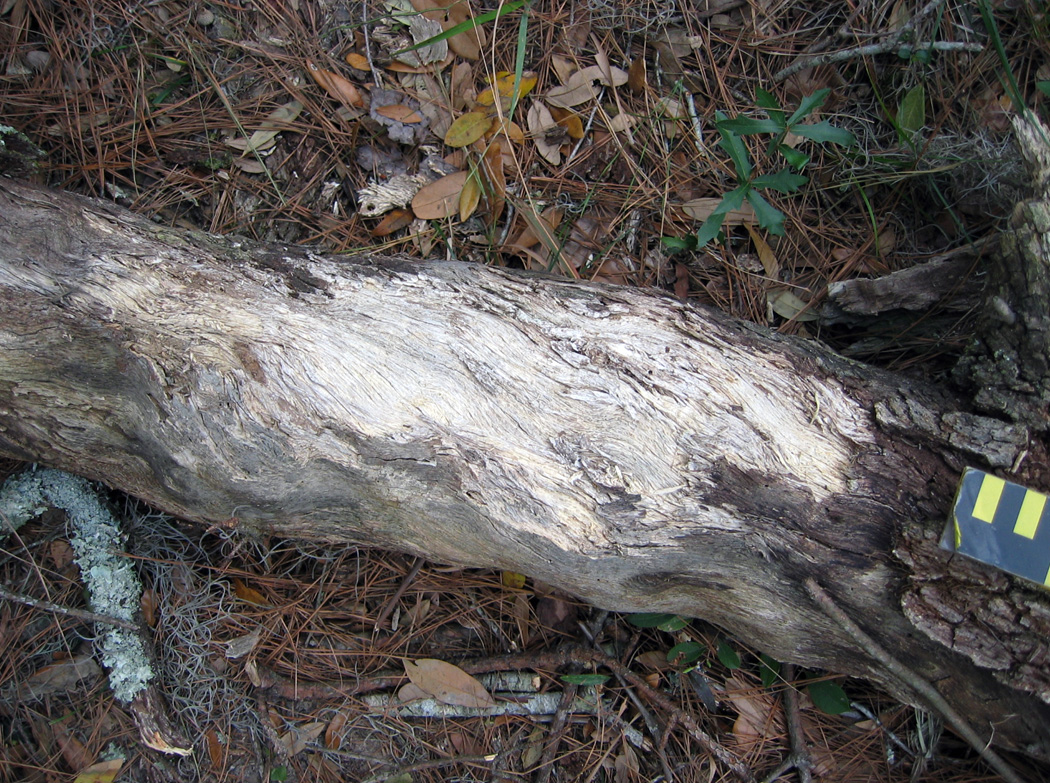 Log on feral-cattle trail, showing chipped wood on surface where hooves dragged across the top, possibly over generations of trail use. White-tailed deer do a similar behavior on their trails, but do not cause such obvious traces. (Photograph by Anthony Martin, taken on Sapelo Island.)
Log on feral-cattle trail, showing chipped wood on surface where hooves dragged across the top, possibly over generations of trail use. White-tailed deer do a similar behavior on their trails, but do not cause such obvious traces. (Photograph by Anthony Martin, taken on Sapelo Island.)
OK, here’s a reminder of something I just said and showed in a photo earlier: these cattle also form trails that wind deeply into the salt marshes. Why? Turns out that instead of restricting themselves to a terrestrial-only diet, they are eating smooth cordgrass (Spartina alterniflora), which grows abundantly in the marshes. This feeding results in their leaving many other traces, such as near-ground-level cropping of Spartina with clean tears, accompanied by considerable trampling of grazed areas. Although I was surprised to discover this for myself several years ago, people who raised cattle on the island in the 19th and early 20th centuries, perhaps through necessity, knew about this alternative foodstuff and fed it to cattle as a substitute for hay. Sure enough, historical references verify the use of smooth cordgrass as part of their diet (of the cattle, not the people, that is).
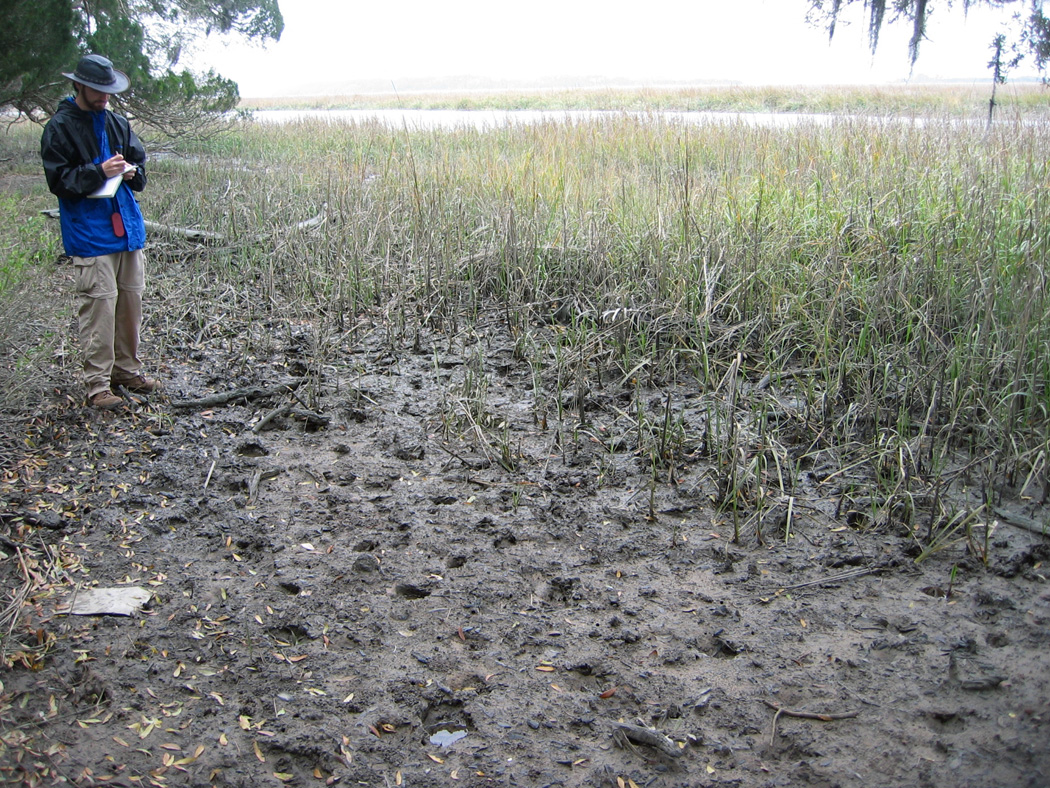 Evidence that feral cattle of Sapelo walk into salt marshes as a herd and eat the smooth cordgrass (Spartina alterniflora) there, based on trampling and overgrazing. Michael Bauman, who was an Emory undergraduate student at the time, for scale. (Photographs by Anthony Martin.)
Evidence that feral cattle of Sapelo walk into salt marshes as a herd and eat the smooth cordgrass (Spartina alterniflora) there, based on trampling and overgrazing. Michael Bauman, who was an Emory undergraduate student at the time, for scale. (Photographs by Anthony Martin.)
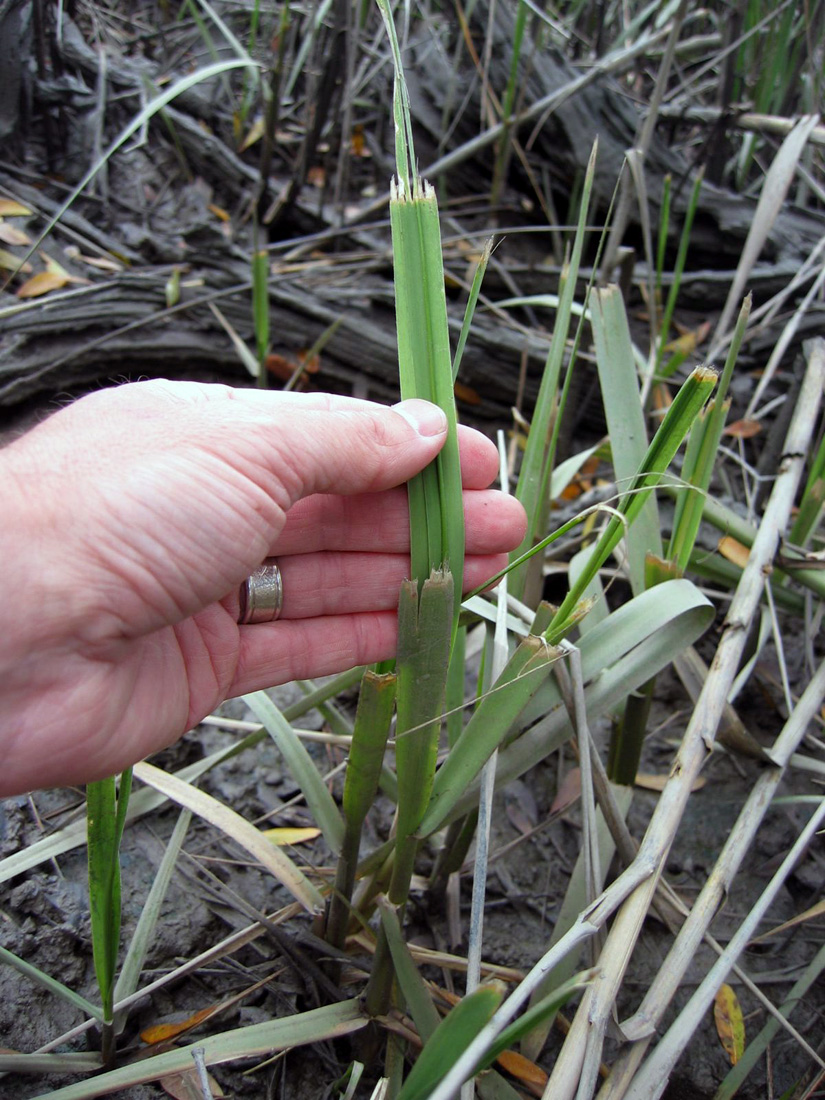 Close-up of traces left on smooth cordgrass from feral cattle grazing, which are at various heights according to the level of their grazing activity. (Photograph by Anthony Martin, taken on Sapelo Island.)
Close-up of traces left on smooth cordgrass from feral cattle grazing, which are at various heights according to the level of their grazing activity. (Photograph by Anthony Martin, taken on Sapelo Island.)
Of course, among the most obvious traces these cattle leave in their wake are the end products of digestion (pun intended), feces. These “cow patties” vary in size depending on both the size of the tracemaker and liquid content of the scat. The bigger the tracemaker and the greater the water content to the plants, the wider the patties, which can exceed dinner-plate size. Similar to the situation on Cumberland Island with its feral horses and their feces, the native dung beetles must not be able to keep up with such a bounty, as I see many unrecycled, dried patties throughout the island, and have nearly stepped on freshly dropped pies that showed no signs of having been discovered by caring dung-beetle mothers.
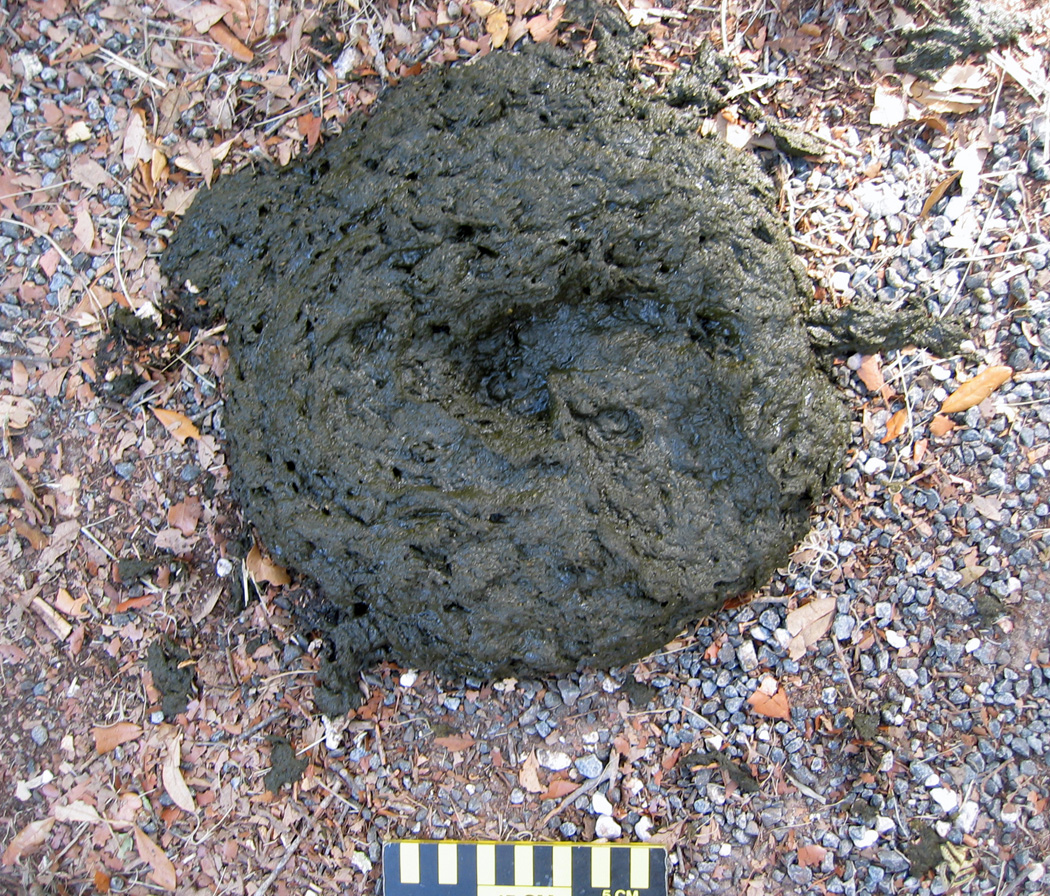 Looks like cow scat. Smells like cow scat. Feels like cow scat. Tastes like cow scat. Good thing we didn’t step in it! But notice that the tracemaker did, leaving a bonus trace (track) on top of its impressive pile. (Photograph taken by Anthony Martin, taken on Sapelo Island.)
Looks like cow scat. Smells like cow scat. Feels like cow scat. Tastes like cow scat. Good thing we didn’t step in it! But notice that the tracemaker did, leaving a bonus trace (track) on top of its impressive pile. (Photograph taken by Anthony Martin, taken on Sapelo Island.)
Given that the northern part of the island has extensive salt marshes flanking the maritime forest, and places with fresh-water sloughs containing more wetland plants, it makes sense that the cattle would stay mostly in that half of the island. The absence of humans on the north end of the island – other than occasional deer hunters, Department of Natural Resources personnel, or crazy ichnologists – is also a plus, as these cattle avoid people whenever possible.
But how does any of this relate to geology and paleontology? Well, because these feral cattle interact so much with Sapelo salt marshes, I actually included these animals as marginal-marine tracemakers in my upcoming book (Life Traces of the Georgia Coast, just in case you needed reminding). This places these bovines in the same category as feral horses – which negatively affect coastal dunes and salt marshes – and feral hogs, which even go into the intertidal zones of beaches for their foraging.
The biggest difference between the cattle and these other two hoofed species, though, is their impact on the marshes. In all of my years of noting cattle tracks and other sign on Sapelo, I have never seen evidence of their going to the beach, or even to the coastal dunes. Instead, they stay in the forests and wetlands, whether the latter are fresh-water or salt-water ones. This possibly reflects how the cattle, within just a few generations, switched back to auroch behaviors of the Pleistocene, preferring to live in wooded wetlands instead of in the terrestrial grasslands we modern humans keep forcing them to graze.
Thus any paleontologists looking into the fossil record of aurochs or their ancestral species – whether of body fossils or trace fossils – might use these present-day clues when prospecting for fossils. This serves as a great example of why I urge paleontologists to pay attention to invasion ecology and conservation biology, in which “ecologically impure” invasive species give us valuable insights on their evolutionary histories.
What else can we learn about these feral cattle and their ecological and geological impacts on Sapelo, especially through studies of their traces? For one, knowing the actual number of cattle on the island would be useful, as their quantity surely relates to how well the island ecosystems can handle present and future populations. But probably more important than this would be better defining their behaviors in the context of these non-native ecosystems. How to do this with a species that stays hidden so well, one that has apparently reverted to a Pleistocene way of life? Fortunately, behaviors can be defined through the ichnological methods I have outlined here. These methods can then easily augment others normally used by conservation biologists, such as trail cameras and direct observation.
Once this is done, we will know much more about these wild cattle than before, and will no longer have to rely on whispered legends of the mysterious bovines of Sapelo Island. Regardless, there is certainly still room for such stories, perhaps even artwork, operas, plays, movies, and music. Cattle have played such an integral role in the development of humanity, there is every reason to suppose that, as long as they continue to live on Sapelo, they and their traces will continue to intrigue us.
Further Reading
Ajmone-Marsan, P., Fernando Garcia, J., and Lenstra, J.A. 2010. On the origin of cattle: how aurochs became cattle and colonized the world. Evolutionary Anthropology, 19: 148-157.
Bailey, C., and Bledsoe, C. 2000. God, Dr. Buzzard, and the Bolito Man: A Saltwater Geechee Talks about Life. Doubleday, New York: 334 p.
McFeeley, W.S. 1995. Sapelo’s People: A Long Walk into Freedom. W.W. Norton, New York: 200 p.
Sullivan, B. 2000. Sapelo Island (GA): Images of America. Arcadia Publishing, Mt. Pleasant, South Carolina: 128 p.
Teal, M., and Teal, J.M. 1964. Portrait of an Island. Atheneum, New York: 167 p. [reprinted by University of Georgia Press, Athens, in 1997: 184 p.]

